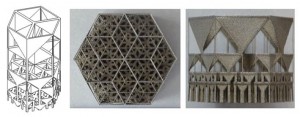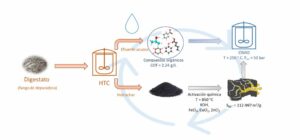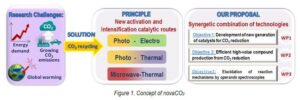![]()
Innovative Volumetric Receivers Based on Selective Laser Melting Techniques (*)
[Autor: Sergio Santiago Sacristán – IMDEA Energy]
Solar receivers constitute one of the key elements to achieve high thermal conversion efficiencies in concentrating solar power plants [1]. Volumetric absorbers is one category of solar receiver. Here absorbers consist of porous materials that are subjected to a high incoming radiative heat flux, absorb progressively the concentrated solar radiation inside their volume, and transfer the absorbed heat by forced convection to a working fluid passing through their structure [2, 3]. Metallic or ceramic absorbers using atmospheric air in open loop configurations or pressurized fluids in closed loop systems [5] are the most representative volumetric absorbers studied today. Atmospheric air volumetric absorbers have several advantages, mainly due to their higher simplicity, flexibility and ease of operation. The overall environmental impact of facilities based on them is typically lower than with other technologies and design, manufacturing and operating costs are also greatly reduced, since the heat transfer fluid is air [6]. As air does not change phase at high temperatures, the maximum temperature in these absorbers is only constrained by the receiver material capabilities.
Research on volumetric receivers is currently justified because their improvements would lead to increase the overall efficiency of solar thermal power plants [1]. The main aspects to consider when designing a volumetric receiver are the correct heat transfer in the solid material (both by conduction and by direct penetration of incident radiation into the structure) and between the solid and the working fluid (by forced convection), and the minimization of the pressure drop between the receiver front and rear faces. The distribution of the received radiative thermal energy throughout the absorber structure depends on its geometrical features (such as pitch, length or wall thickness), the direction of incident solar radiation, the optical properties of the solid material, and its thermal conductivity. The convective heat transfer and pressure drop depend on the wetted and cross-sectional areas of the receiver and the internal flow field variables. The design of volumetric receivers is thus one of conjugate heat transfer processes and interconnected requirements, where trade-offs between concurrent aspects are common.
Variable geometry receivers have the potential to address most of the main problems still encountered in monolithic absorbers, where the incoming radiative heat flux is almost completely absorbed in the front region (which leads to high thermal emission losses). On the contrary, absorbers of variable porosity enhance the diffusion of incident thermal radiation through a progressive reduction of the porosity and thus shift the absorption of radiation towards the rear. This reduces emission losses and, as a result, increases the overall thermal conversion efficiency. Configurations of variable geometrical properties along the absorber depth can control and optimize both radiation absorption and heat convection along the flow streamwise direction.
New advances in manufacturing techniques have supported research into volumetric absorbers of high efficiency by allowing for the fabrication of novel intricate geometries. This is the case of Selective Laser Melting (SLM), which employs a laser beam to melt successive layers of powder, and it makes possible the construction of complex 3-dimensional (3D) structures [7] which would not be feasible with conventional machining tools. SLM has been used for advanced cooling applications in injection molding processes, and it has also been validated for extremely compact heat exchangers configurations in thermodynamic power cycles [8]. SLM is now being applied within the framework of the European project STAGE-STE for developing volumetric receivers of variable porosity [9].

Figure 1. (Left) Concept of variable porosity volumetric absorber; (Right) Volumetric absorber manufactured by Selective Laser melting (SLM) technique.
References:
[1] M. Romero and J. Gonzalez-Aguilar, WIREs Energy Environ. 3, 42–59 (2014).
[2] T. Fend, R. Pitz-Paal, O. Reutter, J. Bauer and B. Hoffschmidt, Sol. Energ. Mat. Sol. C. 84, 291-304 (2004).
[3] B. Hoffschmidt, V. Fernandez, A. G. Konstandopoulos, I. Mavroidis, M. Romero, P. Stobbe and F. Tellez, “Development of ceramic volumetric receiver technology”, in Proceedings of 5th Cologne Solar Symposium, edited by K. H. Funken et al. (Forschungsbericht 2001-10, DLR Cologne, Germany, 2001), pp. 51–61.
[4] C. K. Ho and B. D. Iverson, Renew. Sust. Energ. Rev. 29, 835–846 (2014).
[5] A. L. Avila-Marin, Sol. Energy 85, 891–910 (2011).
[6] F. Gomez-Garcia, J. Gonzalez-Aguilar, S. Tamayo-Pacheco, G. Olalde and M. Romero, Energy Procedia 57, 457–466 (2014).
[7] J. P. Kruth, B. Vandenbroucke, J. Van Vaerenbergh and P. Mercelis, “Benchmarking of different SLS/SLM processes as rapid manufacturing techniques”, in Int. Conf. Polymers & Moulds Innovations (PMI), Gent, Belgium (2005).
[8] L. Crema, F. Alberti, E. Wackelgard, B. Rivolta, S. Hesse, L. Luminari, D. Hislop and B. Restall, Energy Procedia 57, 447–456 (2014).
(*) F. Alberti, S. Santiago, M. Roccabruna, S. Luque, J. González-Aguilar, L. Crema and Manuel Romero, “Numerical Analysis of Radiation Propagation in Innovative Volumetric Receivers Based on Selective Laser Melting Techniques”, in Proceedings of SolarPACES 2015, Cape Town, South Africa, 2015


